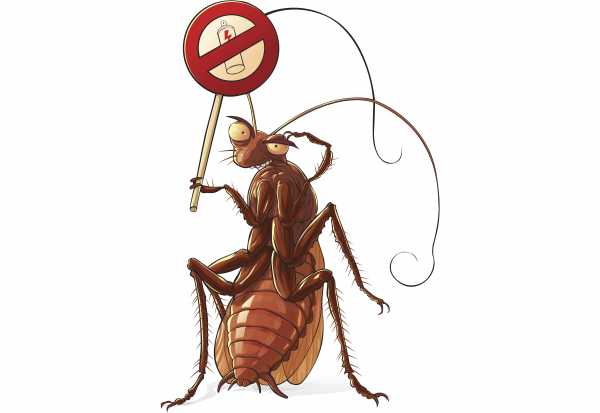
Anyone who has ever lived in a house or apartment infested with cockroaches knows what stubborn pests they can be. They’re just really, really hard to kill.
If you try to hit them with a rolled-up newspaper, they’ll scamper away. An infestation of a few can become hundreds quickly. And insecticides designed to kill the buggers don’t always work.
Here’s an important reason why: Just like bacteria can evolve resistance to antibiotics, roaches can evolve resistance to insecticides.
If that wasn’t horrifying enough, a new study in Scientific Reports finds that when German cockroaches (the most common species of this household pest) evolve resistance to one formulation of insecticide, they can become resistant to other formulations as well. That means one unsuccessful pest control treatment can kick-start a cycle of unsuccessful pest control.
“Roaches, in their evolutionary history, have been exposed to everything out there, and so they’re multi-resistant today,” Michael Scharf, a Purdue University entomologist who worked on the study, says. (It’s okay if, at this point in the story, you want to scream aloud.)
So what can we do about it? Fortunately, “it’s not a doomsday scenario,” Scharf says.
There are still ways to fight back.
Why cockroaches are so good at evolving resistance to insecticide
Cockroaches scuttling around in our homes aren’t just nasty to look at; they can also be bad for our health. Roach dust, made of tiny bits that roaches shed from their bodies, is an allergen and can trigger or worsen asthma symptoms. Roaches also carry pathogens, like salmonella and E. coli, that can make us sick.
How, you might wonder, does a roach become resistant to poison? A single organism — a single roach, a single bacterium — doesn’t become resistant to a chemical. The population does.
In any given population, there’s variation. Some individuals may have an inborn resistance to a chemical while others do not. When a population is treated with that chemical, the ones without the resistance die and the ones with it live. The survivors pass down their resistance genes to the next generation. And then suddenly, you end up with a population of individuals mostly resistant to that chemical.
Cockroaches, in some ways, are even better at evolving resistance than bacteria. They can also evolve behavioral resistance (something bacteria can’t do), meaning they know to avoid roach poison and pass those avoidance genes down to the next generation.
The problem of cockroaches quickly developing resistance to insecticides has been a problem since the 1950s. The Purdue University researchers who did the Scientific Reports study wanted to test some new ways to deal with it in low-income communities that suffer disproportionately from asthma linked to cockroach allergens.
“We were trying to figure out how we, or anybody, could go into low-income housing and help knock the populations down quickly in a cost-effective way,” Scharf says. “There’s not a lot of money in low-income housing to deal with this, but it’s a problem for the people who are forced to live there.”
They tried three different strategies to kill the roaches and avoid the problem of insecticide resistance.
One strategy used three different pesticides, one treatment at a time (meaning they started with one chemical and then moved to another). Another used a mixture of pesticides for the entire course of treatment. And in a third, the researchers pre-screened the roaches for resistance and treated them with the chemical they were the most susceptible to.
“What we were surprised about was that virtually nothing worked,” Scharf says. And that’s because roaches, as a population, quickly — within four months of study — developed resistance to one or more of the poisons; or perhaps they were largely immune to begin with. Lab tests confirmed that cross-resistance was developed in the roaches in around two generations. And so the roach populations remained flat or even increased in numbers.
The only exception was with the third strategy, where the researchers pre-monitored the bugs to find their greatest weakness. The problem is “not everybody can do that,” Scharf says, as it takes laboratory testing to confirm.
If poison doesn’t work, what does?
The upshot, Scharf says, is that low-income housing managers, residents, and really anyone dealing with roaches in their homes have options beyond chemicals to control roaches. (The over-the-counter poisons residents can buy can ramp up resistance and make the problem worse, he says.)
It’s usually more expensive, he says, but physically removing the insects can lead to a more lasting solution. That includes using special vacuums meant to suck up the roaches (which is also labor-intensive), laying down sticky traps, and educating residents to take out their trash once a day or to not leave out pet food (a roach favorite). These approaches have added benefits, too: namely, they’re safer for pets who might accidentally eat insecticide.
And if property managers cut down on their use of insecticides, Scharf says, those chemicals may become effective again. Roaches only live 100 days and have many offspring. In a few generations, they can re-evolve the susceptibility to insecticide.
That’s because there may be costs to being resistant to insecticide. For instance, it’s possible the roaches that are resistant to insecticide also don’t live as long. Or perhaps they’re more susceptible to disease. And in time, those traits will be selected out of the population.
“[Insecticide] susceptibility will come back in populations for sure,” Scharf says. We just have to be more careful when we use these chemicals.
Sourse: vox.com






